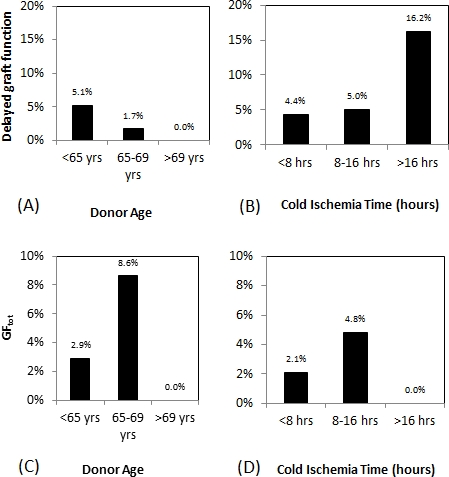The Oldest and Coldest in Kidney Paired Donation: Experience of the National Kidney Registry.
1Urology, David Geffen School of Medicine at UCLA, Los Angeles, CA
2National Kidney Registry, Babylon, NY.
Meeting: 2016 American Transplant Congress
Abstract number: 127
Keywords: Donation, Graft function, Graft survival, Resource utilization
Session Information
Session Name: Concurrent Session: Kidney Donor Surgery and Outcomes
Session Type: Concurrent Session
Date: Sunday, June 12, 2016
Session Time: 4:30pm-6:00pm
 Presentation Time: 4:54pm-5:06pm
Presentation Time: 4:54pm-5:06pm
Location: Ballroom B
OBJECTIVES: To evaluate renal allograft efficacy and survivability in elderly donors and prolonged cold ischemia time (CIT).
METHODS: 1,402 living donor kidney transplants from 02/2008-06/2015 recorded by the National Kidney Registry were included. Transplants were classified by donor age <65, 65-69, or >69 and CIT <8, 8-16, or >16 hours. Incidence of delayed graft function (DGF), graft failure in the first post-operative year (GF1), overall graft failure (GFtot), and median nadir creatinine value were evaluated.
RESULTS: DGF occurred in 4.9% of transplants (n=69). Donor age was not associated with a significant effect on DGF (p = 0.4) (Fig 1A)  . CIT >16 hours was associated with a significant increase in DGF compared to CIT <16 hours (p = 0.005) (Fig 1B)
. CIT >16 hours was associated with a significant increase in DGF compared to CIT <16 hours (p = 0.005) (Fig 1B)  . GF1 occurred in 2% of patients transplants (n=21). Donor age did not produce a significant effect on GF1 (p = 0.99). CIT 8-16 hours was associated with an increase in GF1 compared to <8 hours and >16 hours (3.4% vs. 2.1% and 0%, p = 0.0221). GF1 did not occur in donors >69 or CIT >16 hours. Multivariate logistic regression analysis for GF1 did not find a significant effect produce by donor age or CIT (p = 0.7650 and p = 0.4381, respectively). GFtot occurred in 3% of transplants (n=43). Donor age did not significantly affect GFtot (Fig 1C)
. GF1 occurred in 2% of patients transplants (n=21). Donor age did not produce a significant effect on GF1 (p = 0.99). CIT 8-16 hours was associated with an increase in GF1 compared to <8 hours and >16 hours (3.4% vs. 2.1% and 0%, p = 0.0221). GF1 did not occur in donors >69 or CIT >16 hours. Multivariate logistic regression analysis for GF1 did not find a significant effect produce by donor age or CIT (p = 0.7650 and p = 0.4381, respectively). GFtot occurred in 3% of transplants (n=43). Donor age did not significantly affect GFtot (Fig 1C)  (p = 0.07). CIT 8-16 hours was associated with increased GFtot compared to CIT <8 hours and >16 hours (Fig 1D)
(p = 0.07). CIT 8-16 hours was associated with increased GFtot compared to CIT <8 hours and >16 hours (Fig 1D)  (p = 0.0110). GFtot did not occur in donors >69 or CIT >16 hours. Cox regression analysis for GFtot did not yield a significant association with donor age or CIT (Table 1)
(p = 0.0110). GFtot did not occur in donors >69 or CIT >16 hours. Cox regression analysis for GFtot did not yield a significant association with donor age or CIT (Table 1)
| Hazard Ratio | 95% CI | |
| Donor age (referent <65 years) | ||
| ≥65 years old | 1.80 | 0.71-4.59 |
| Cold-ischemia time (referent < 12 hours) | ||
| ≥12 hours | 0.95 | 0.42-2.13 |
. Across all donor ages and CIT, nadir median creatinine values were 1.1-1.2.
CONCLUSIONS: Donor age does not significantly affect DGF incidence and is not associated with an increase in graft failure. CIT >8 hours increased the incidence of DGF, and CIT 8-16 hours was associated with a minor but significant increase in incidence of graft failure.
CITATION INFORMATION: Nassiri N, Kwan L, Sinacore J, Veale J. The Oldest and Coldest in Kidney Paired Donation: Experience of the National Kidney Registry. Am J Transplant. 2016;16 (suppl 3).
To cite this abstract in AMA style:
Nassiri N, Kwan L, Sinacore J, Veale J. The Oldest and Coldest in Kidney Paired Donation: Experience of the National Kidney Registry. [abstract]. Am J Transplant. 2016; 16 (suppl 3). https://atcmeetingabstracts.com/abstract/the-oldest-and-coldest-in-kidney-paired-donation-experience-of-the-national-kidney-registry/. Accessed January 2, 2026.« Back to 2016 American Transplant Congress
